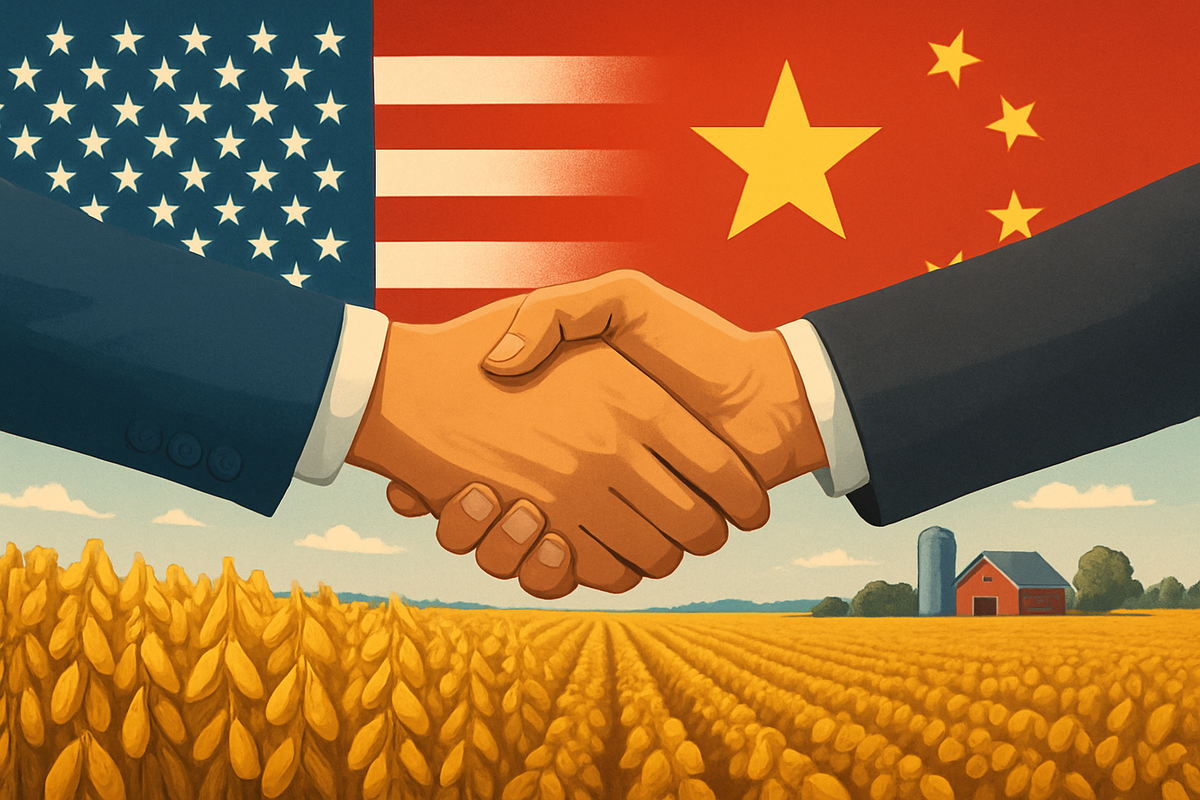
The recent "Deal on Economic and Trade Relations" between the United States and China, announced in late October and early November 2025, has sent a wave of cautious optimism through global agricultural commodity markets. This framework agreement aims to dial back years of trade hostilities, with China committing to substantial increases in U.S. agricultural purchases, particularly soybeans. While the immediate reaction has been a surge in commodity prices, particularly for soybeans, market participants remain watchful, understanding that the devil will be in the details of implementation and the resolution of lingering non-tariff barriers.
This tactical truce, following intense negotiations, signals a potential de-escalation of a trade conflict that has profoundly reshaped global agricultural supply chains. The agreement's success in providing stability and consistent demand for American farmers, who have endured significant volatility and financial strain, will be a critical test of its long-term viability.
Detailed Coverage: A Framework for De-escalation
The "Deal on Economic and Trade Relations with China" emerged from high-level discussions between President Donald Trump and President Xi Jinping in late October 2025. The core of the agreement centers on China's commitment to significantly increase its imports of U.S. agricultural products. Specifically, China has pledged to purchase at least 12 million metric tons (MMT) of U.S. soybeans during November and December 2025. Looking further ahead, China has committed to an annual minimum of 25 MMT of U.S. soybeans for the subsequent three years (2026, 2027, and 2028). Beyond soybeans, the agreement includes the resumption of purchases for U.S. sorghum and hardwood logs.
A crucial component of this framework is the mutual adjustment of tariffs. China is expected to reduce or suspend retaliatory tariffs and remove non-tariff countermeasures that had been in place since March 4, 2025. These tariffs had impacted a wide array of U.S. agricultural products, including chicken, wheat, corn, cotton, sorghum, soybeans, pork, beef, aquatic products, fruits, vegetables, and dairy products. In a reciprocal move, the U.S. has agreed to lower its "fentanyl-related tariffs" on Chinese goods from 20% to 10% and paused rare-earth export restrictions. This reciprocal action aims to create a more favorable environment for bilateral trade.
The initial market reaction has been swift and largely positive, albeit with underlying caution. U.S. soybean futures have surged to a 15-month high, experiencing their most significant monthly gain in nearly five years, driven by the renewed Chinese purchase commitments. Wheat futures have also seen increases, and corn futures registered modest gains. The pork and beef sectors, which faced severe disruptions earlier in 2025 due to tariffs as high as 172% on U.S. pork and the expiration of export licenses for hundreds of U.S. beef facilities, are now anticipating renewed market access. However, agricultural trade consultants emphasize that significant non-tariff barriers, such as facility registrations and biotechnology approvals, persist and will require further attention for consistent market access.
Corporate Fortunes: Winners and Shifting Sands
The renewed commitment to increased US-China agricultural trade is poised to create distinct winners among publicly traded companies, while also necessitating strategic adjustments for others. Companies deeply embedded in the trading, processing, and input supply for major U.S. agricultural exports stand to benefit significantly.
Leading agricultural commodity traders and processors are among the clearest beneficiaries. Archer Daniels Midland Company (NYSE: ADM), a global leader in agricultural processing and oilseed crushing, is expected to see a direct boost to its Ag Services and Oilseeds segment. Increased U.S. soybean exports to China will translate into higher demand for its merchandising, storage, transportation, and crushing operations. Similarly, Bunge Global SA (NYSE: BG), another major agribusiness and food company with extensive involvement in oilseed processing and grain trading, will likely experience increased throughput in its processing facilities and higher volumes across its trading and shipping networks, benefiting its Agribusiness segment.
Seed and crop protection chemical companies also stand to gain. Increased demand for crops like soybeans encourages U.S. farmers to expand acreage, which, in turn, drives sales for companies providing essential agricultural inputs. Corteva, Inc. (NYSE: CTVA), a significant provider of soybean seeds and crop protection chemicals, is well-positioned for increased sales of its proprietary seeds and associated herbicides, insecticides, and fungicides, particularly in North America, as planting intentions for soybeans rise. Furthermore, while not specific publicly traded entities, U.S. pork and beef producers and processors will find significant relief and upside from China's renewed purchases and tariff reductions, having faced severe market access issues previously.
Conversely, the "losers" in this scenario are primarily those who benefited from the absence of U.S. products in the Chinese market during the trade tensions. South American agricultural exporters, particularly Brazil and Argentina, dramatically increased their soybean and grain exports to China during the trade war, capturing a significant market share. With China's renewed commitment to U.S. agricultural products, these alternative suppliers may face increased competition and a reduction in their elevated market share in China, potentially leading to downward pressure on their domestic commodity prices.
Wider Significance: Reshaping Global Agricultural Dynamics
The recent US-China trade steps are not isolated events but are deeply embedded within broader industry trends, creating ripple effects across the global agricultural landscape and influencing regulatory frameworks. The protracted trade tensions, which saw U.S. agricultural exports to China reportedly fall by nearly 40% between June 2024 and June 2025, have fundamentally reshaped supply chains.
One of the most significant broader trends is the accelerated supply chain realignment. China, driven by food security concerns and a desire for diversification, has actively sought alternative suppliers for key commodities like soybeans and corn, predominantly from Brazil and Argentina. This strategic shift means that even with renewed U.S. purchases, China's reliance on a single source has diminished, leading to a more diversified global sourcing strategy for agricultural products. This diversification creates a more competitive environment for all exporting nations.
The ripple effects on competitors and partners are substantial. During the peak of the trade war, countries like Brazil saw their soybean exports to China surge, capturing a dominant share of the market. Now, as U.S. agricultural exports rebound, these alternative suppliers may face intensified competition and a potential reduction in their market share in China. This could lead to downward pressure on commodity prices in those regions. For other trading blocs, such as the European Union and Australia, the dynamic US-China relationship influences their own competitive positioning in global agricultural markets.
From a regulatory and policy perspective, the agreement highlights the ongoing challenge of non-tariff barriers (NTBs). While tariffs are being addressed, issues such as cumbersome sanitary and phytosanitary (SPS) measures, import licensing complexities, and inefficient customs procedures continue to impede trade. The U.S. government has historically provided significant economic aid to farmers to offset trade war losses, underscoring the policy implications of such disputes. Historically, the 2018-2019 trade war serves as a stark precedent, demonstrating how retaliatory tariff cycles can severely impact agricultural exports and farmer livelihoods, echoing patterns seen in earlier disputes like the "Tires vs. Chicken" case in 2009.
What Comes Next: Cautious Stability Amidst Strategic Shifts
Looking ahead, the future of US-China agricultural trade presents a landscape of cautious stability, driven by the new framework, but also marked by persistent challenges and the need for strategic adaptations. In the short term, the market anticipates a surge in confidence and stabilization or modest increases in commodity prices, particularly for soybeans, corn, and pork. Initial tariff reductions are expected to make U.S. products more competitive, leading to increased volumes through U.S. export terminals. China's state-owned buyer COFCO has already confirmed initial purchases, and reports suggest China is seeking to buy U.S. wheat for the first time in over a year. However, some analysts view this as a "tactical pause," with skepticism about China fully meeting its commitments, given past unfulfilled promises.
In the long term, a scenario of cautious stability appears most likely, where the new framework largely holds, leading to consistent but not necessarily booming trade. China is expected to largely meet its purchase commitments, and tariffs are likely to remain manageable. However, China's strategic imperative for food security and supply chain resilience means it will likely continue its aggressive diversification of import sources, with South American producers remaining crucial suppliers. China also aims to boost domestic agricultural production and reduce soybean meal in animal feed, potentially limiting long-term U.S. market share.
For U.S. farmers and businesses, strategic adaptations are paramount. Market diversification, focusing on expanding into other emerging markets in Southeast Asia, Latin America, and Africa, is a critical strategy. Investing in supply chain resilience through multiple sourcing options and flexible logistics is crucial to mitigate future disruptions. There's also a potential pivot from volume-driven exports to value-added innovation and crop diversification. The U.S. government will need to focus on robust enforcement mechanisms for trade agreements and continued strategic trade diplomacy.
Market opportunities include renewed, albeit cautious, access for U.S. soybeans, sorghum, and hardwood logs, and potential for new horticultural products. Challenges, however, remain significant: the lingering threat of renewed trade hostilities, intense global competition from diversified suppliers, China's unwavering food security goals, and potential new non-tariff barriers. Investors should brace for a more competitive and potentially volatile environment where agility and diversification will be key.
Wrap-up: A New Chapter of Volatility and Opportunity
The recent US-China "Deal on Economic and Trade Relations" marks a significant, albeit fragile, turning point in a relationship that has profoundly impacted global agricultural markets. The immediate surge in soybean prices and renewed purchase commitments offer a much-needed respite for American farmers and exporters, who have navigated years of uncertainty and declining market access. This framework agreement provides a glimpse of stability but underscores the lasting structural changes that have occurred.
The market assessment reveals that while the truce is positive, the U.S. agricultural sector faces an uphill battle to fully reclaim its previous market dominance in China. Prior to this agreement, U.S. agricultural exports to China were projected to decline significantly, with China diversifying its sources to countries like Brazil, which solidified its position as a dominant supplier. China's domestic economic headwinds and its strategic drive for food self-sufficiency will continue to influence its import demands, irrespective of trade agreements.
The lasting impact of the trade tensions is a fundamentally realigned global agricultural supply chain. China's diversification strategy means that the U.S. will operate in a more competitive environment, necessitating continued efforts by American farmers and businesses to seek new markets and innovate. The emphasis on resilient food systems, through investments in agri-tech and sustainable practices, is a direct consequence of past disruptions.
For investors, vigilance is key. The primary focus should be on China's adherence to its stated purchase commitments for soybeans and other agricultural products. Any deviation could swiftly impact commodity prices and farmer sentiment. Investors should also closely monitor the political landscape for any signs of a "resurgent trade war" and track global commodity market dynamics, including the strength of competing suppliers like Brazil. Furthermore, watching China's domestic economic health, U.S. efforts in supply chain diversification, and investments in agri-tech and sustainability will provide crucial insights into the evolving landscape of global agricultural trade.
This content is intended for informational purposes only and is not financial advice






